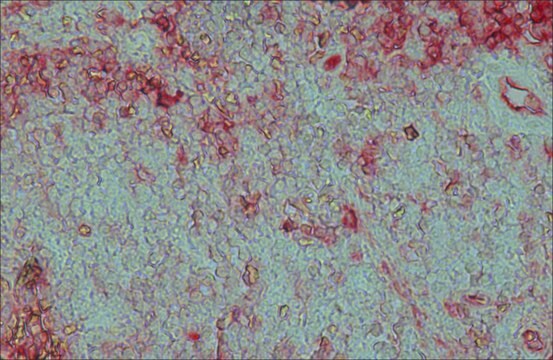227040
Anti-Cholera Toxin, B-Subunit Goat pAb
lyophilized, Calbiochem®
Synonym(s):
Anti-Cholera Antibody, Cholera Toxin Detection, Goat Anti-Cholera Toxin
Sign Into View Organizational & Contract Pricing
All Photos(1)
About This Item
UNSPSC Code:
12352203
NACRES:
NA.43
Recommended Products
biological source
goat
Quality Level
antibody form
serum
antibody product type
primary antibodies
clone
polyclonal
form
lyophilized
contains
≤0.1% sodium azide as preservative
manufacturer/tradename
Calbiochem®
storage condition
OK to freeze
isotype
IgG
shipped in
ambient
storage temp.
2-8°C
target post-translational modification
unmodified
General description
Goat polyclonal antibody supplied as lyophilized undiluted serum. Recognizes cholera toxin B-subunit.
Recognizes the B-subunit of cholera toxin.
This Anti-Cholera Toxin, B-Subunit Goat pAb is validated for use in Immunoblotting, Frozen Sections, Immunocytochemistry, ELISA for the detection of Cholera Toxin, B-Subunit.
Immunogen
Vibrio cholerae
non-denatured Cholera Toxin, B-subunit
Application
Immunoblotting (see application references)
Frozen Sections (1:4000; see application references)
Immunocytochemistry (1:200; see application references)
ELISA (1:10,000; see application references)
Frozen Sections (1:4000; see application references)
Immunocytochemistry (1:200; see application references)
ELISA (1:10,000; see application references)
Warning
Toxicity: Standard Handling (A)
Physical form
Undiluted serum.
Reconstitution
Reconstitute in 100 µl dH₂O. Further dilute with aqueous buffers, such as PBS.
Other Notes
Antibody should be titrated for optimal results in individual systems.
Vadolas, J., et al. 1995. Eur. J. Immunol. 25, 969.
Craig, J.P. 1971. Microbial Toxins 2A, 189.
Selected Citations
Peters, I., et al. 2009. Biochim. Biophys. Acta1788, 964.
Balasubramanian, N., et al. 2007. Nature Cell Biology9, 1381.
Nemchinov, L.G., Et al. 2000. Arch. Virol.145, 2557.
Craig, J.P. 1971. Microbial Toxins 2A, 189.
Selected Citations
Peters, I., et al. 2009. Biochim. Biophys. Acta1788, 964.
Balasubramanian, N., et al. 2007. Nature Cell Biology9, 1381.
Nemchinov, L.G., Et al. 2000. Arch. Virol.145, 2557.
Legal Information
CALBIOCHEM is a registered trademark of Merck KGaA, Darmstadt, Germany
Not finding the right product?
Try our Product Selector Tool.
Storage Class
11 - Combustible Solids
wgk_germany
WGK 1
Certificates of Analysis (COA)
Search for Certificates of Analysis (COA) by entering the products Lot/Batch Number. Lot and Batch Numbers can be found on a product’s label following the words ‘Lot’ or ‘Batch’.
Already Own This Product?
Find documentation for the products that you have recently purchased in the Document Library.
J Müthing et al.
Glycoconjugate journal, 14(1), 19-28 (1997-01-01)
In this study the comparative TLC immunostaining investigation of neutral GSLs and gangliosides from human skeletal and heart muscle is described. A panel of specific polyclonal and monoclonal antibodies as well as the GM1-specific choleragenoid were used for the overlay
Mia N Kelly et al.
American journal of physiology. Regulatory, integrative and comparative physiology, 318(6), R1058-R1067 (2020-04-30)
Circadian rhythms are endogenous and entrainable daily patterns of physiology and behavior. Molecular mechanisms underlie circadian rhythms, characterized by an ~24-h pattern of gene expression of core clock genes. Although it has long been known that breathing exhibits circadian rhythms
Sara Letzner et al.
The European journal of neuroscience, 52(6), 3561-3571 (2020-05-10)
Left-right differences in the structural and functional organization of the brain are widespread in the animal kingdom and develop in close gene-environment interactions. The visual system of birds like chicks and pigeons exemplifies how sensory experience shapes lateralized visual processing.
Annabel Guichard et al.
Cell host & microbe, 14(3), 294-305 (2013-09-17)
Cholera toxin (CT), a virulence factor elaborated by Vibrio cholerae, is sufficient to induce the severe diarrhea characteristic of cholera. The enzymatic moiety of CT (CtxA) increases cAMP synthesis in intestinal epithelial cells, leading to chloride ion (Cl(-)) efflux through
Latoya L Allen et al.
Respiratory physiology & neurobiology, 261, 15-23 (2018-12-28)
Spinal chloride-dependent synaptic inhibition is critical in regulating breathing and requires neuronal chloride gradients established by cation-chloride cotransporters Na+-K+-2Cl- (NKCC1) and K+-Cl- (KCC2). Spinal transection disrupts NKCC1/KCC2 balance, diminishing chloride gradients in neurons below injury, contributing to spasticity and chronic
Our team of scientists has experience in all areas of research including Life Science, Material Science, Chemical Synthesis, Chromatography, Analytical and many others.
Contact Technical Service








